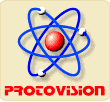Introduction to C64 crossdevelopment
by
Lasse ??rni
Welcome to the very first rant about crossdeveloping for the C64 and the methods I personally use (not necessarily most recommended)
This article was
originally published at covertbitops.cjb.net on 6th march 2002.
0. Background
Some of the opinions in this rant are quite radical. To have some background to them I’ll first give my short C64 history:
- 1986 Got hands on a C64
- 1987 BASIC experiments
- 1988–1991 Assembly language experiments. Not much achieved, all bigger projects are unfinished. (part of it can be blamed on primitive tools: SEUCK and MikroAssembler)
- 1992– Mostly only playing on C64 from this point onwards
- 1995 Discovered C64 emulation
- 1996 or 1997 C64 stops working
- 1998 Got idea of crossdevelopment by researching the internet; work on Metal Warrior game started; unforeseen levels of C64 productivity
- 1999–2000 Crossdevelopment, crossdevelopment, crossdevelopment
- 2001–2002 Acquired working C64 hardware again, crossdevelopment continues :)
So, basically I have crossdevelopment to thank for all my C64 achievements worth mentioning.
1. What is crossdevelopment
Crossdevelopment is using a different (usually, more powerful) platform than the target platform for running some or all of the programs used in development. (assembler, text editor, possibly graphics/music editor)
Advantages of C64 crossdevelopment:
- Shorter compile times because of CPU power
- Batch files or makefiles can automatize compiling process
- Editing can be easier or faster on modern utilities (for example a PC based text editor for writing source code)
- Files on a harddisk are easier to manage, as well as more reliably stored than on floppy disk (though, some people have already harddisk- equipped C64’s so in that case it isn’t an advantage)
Disadvantages of C64 crossdevelopment:
- If testing on an emulator, remember that graphics (TV image blurriness!) & sound emulation are not 100% accurate yet, and probably will never be. Processor- & chip-emulation are very accurate nowadays in good emulators (for example CCS64, VICE). If your program runs in both CCS64 & VICE you can be pretty much sure that it will also on the real machine.
My experience with different results on different emulators was the loader bug in Metal Warrior 2 (version 1.1p). If loading the intro-part (loading picture) first, the game would later freeze when it was loading the first ingame level file. In VICE this bug never showed up but on CCS64 & a real C64 it did. The actual cause of this bug is a mystery even today (it was later removed by integrating the MW3 loader fully) but the point is to show the importance of testing on many emulators.
- If testing on the real machine, some effort is required to transfer the program over (for example, with Star Commander and an X1541 cable). But I strongly recommend testing on the real machine, whenever possible!
- Making small test changes to code & data (for example with a freezer cartridge) during run-time can be more convenient than recompiling the project within the crossdevelopment-system.
Crossdevelopment can also be „mixed“: for example a C64 emulator is run to use C64 based graphics & music editors. The resulting datafiles are then extracted from a D64 disk-image as needed (VICE has also the possibility to „mount“ a hard disk directory directly; no need for disk images)
2. My principles and tools
My crossdevelopment principle is very extreme but it is the most efficient for me personally. Simply put, it is:
- No C64-based utilities are used in development
At first glance this seems extremely crazy, when one is developing a C64 program it would seem logical to use the tried & true utilities, at least for some tasks. But let me explain how I have solved things (and I haven’t always obeyed this rule 100% :))
2.1 The source code
This one is simple: I use TSE (DOS based editor, great keyboard commands) to edit the source code. I split source code to multiple files based on their purposes (for example all raster interrupt code goes to one file, all scrolling code goes to another) to keep things manageable.
Also, with the memory not being a concern like in C64 based combined editor/assemblers (Turboassembler for example) I can comment as much as I want and use as long label names as needed.

2.2 Background and sprite graphics
Drawing sprites is usually a very generic task, it is quite the same from project to project. Therefore a C64 based sprite editor would usually fit the task just fine, without need for any customizations (for example the SEUCK sprite editor)
![]()
However, in background graphics problems quickly arise. SEUCK would be fine for simple scrolling games, but
- It is limited to vertical-scrolling backgrounds only
- Blocks are 5×5 chars. What if you want 4×4?
So, it is likely that a custom utility is needed. I have no doubt that I will write a DOS/Windows based editor in C language faster than I could write a C64 based editor in assembly language (and an editor written in BASIC would be intolerably slow for any larger amounts of work, in most cases) This, like everything, is a matter of preference. For others it can be faster to write a C64 based utility, even in assembly language.
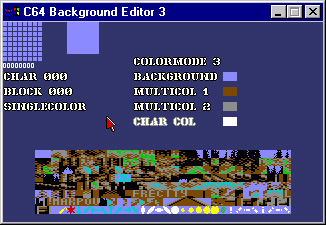
And once I got my first background editor finished, the common routines and graphics were also convenient to use for a PC-based sprite editor as well.
2.3 Bitmap pictures
I got used to Deluxe Paint during my Amiga programming years. Therefore, painting in a Deluxe Paint-style program (nowadays I use GRAFX2 for better NT/W2K compatibility) feels most natural to me. So, I set up a C64-like palette, a 2×1 grid and brush size and begin painting. :)
Grafx2 is available here.
The problem is this: C64 can have only three different colors + background color in a character cell. But how I know if I exceed this limit in a non-C64 paint program? There is no way, except by examining the pixels by eye, or testing the picture within a C64 program.
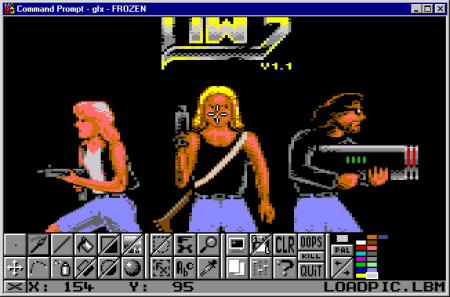
Although work by this method is fast for me even with all testing involved, it is not fully satisfying. A PC-based C64 paint program would be ideal, but a paint program is a much bigger task than a background char-set editor; possibly I won’t ever write one. The other option worth investigating for me is to actually try to learn some C64 paint program so well that I can match my speed on Deluxe Paint :) Probably it’d have to be mouse-based, because I am very aware of my speed on Koalapainter (definitely not the best joystick paint program, it’s just the one I have most experience of)
For the conversion of IFF/LBM pictures to C64 usable format, I use simple, self-written utilities.
I know this method is a bit weird and therefore I’d rather recommend using a C64 bitmap paint program. However, it’s worth trying once in a lifetime!
2.4 Music and sound
Like in the previous chapter, the method I’d recommend most is a C64 based editor (mainly because there are so many available) But now let’s examine what I wanted…
To have maximum control over my programs, I’ve always preferred using a self-written playroutine. Not many playroutines offer sound effect support anyway, and many playroutines (with lots of features) are kind of slow…
So far, I’ve used 3 options:
- Editing music directly in source code as byte data. Symbolic defines can help this process (for example note names) but still I can’t really recommend this method to anyone working today. This is useful if one has to squeeze every last byte out of the music data.
For example in Metal Warrior 3 memory was extremely tight, so I programmed a „subroutine call“ system in the music sequence data. Thus the music data became almost like program code, and possibly source-code editing was even the most efficient way this time. (I’m sure constant copying & pasting when trying to find the most optimal „subroutine“ lengths is faster in a text editor than in a music editor :))
- Writing a C64 based editor. I did this with SadoTracker, and used it with much success for some time. Extracting the ready tunes from diskimages was a pain, though (I automated it later)
- GoatTracker. A PC based C64 music editor supporting either reSID emulation or the HardSid (yes, I acquired one, after first coding the GoatTracker HardSid support „blind“, relying on the docs) Needless to say, I’m very satisfied with this :)
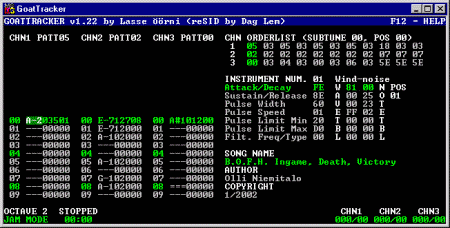
2.5 Assembling
My crossassembler of choice is DASM by Matthew Dillon, but there’s a lot of good crossassemblers to choose from. Some features I require from an assembler (not much really):
- Able to handle big files (practically, the assembler must have been compiled with a 32bit C compiler)
- Macro and repeat statement support
- Code generation to different logical vs. physical address; for example code executed in the disk drive or depacker code to be copied into another memory location
- Possibility to include other source code files and raw binary data
So basically the „main program“ source code file for my productions looks like this:
processor 6502
;DASM supports multiple processors
org startaddress
..main program code here..
include
other_sourcecodefile_1.s
include other_sourcecodefile_2.s
…
include other_sourcecodefile_n.s
incbin
some_data.bin
incbin some_more_data.bin
And the whole program is assembled by giving an instruction like
dasm program.s -oprogram.prg -p3
(-p3 enables 3 passes for assembly)
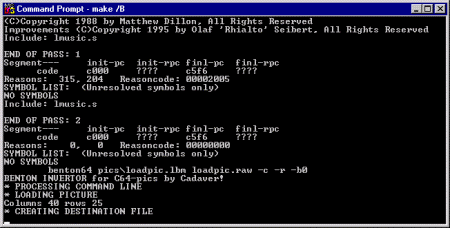
2.6 Controlling the compile process
A complex production might be composed of many files that are for example loaded from disk as needed. So it would be clumsy to have to type all assembling & data-manipulation commands by hand each time something needs to be changed.
A batch file will do fine in most cases; simply gather all commands required to fully compile the program.
But through C programming I’ve learned a more elegant solution: the use of a makefile. A makefile lists the dependencies for all target files and the commands needed to create them. The makefile can then executed by a C compiler’s make utility, and a file is re-created only if some of the files it’s depending on is changed (saves time). Here’s an example of a makefile, showing a main program which depends on some source code files and a picture file: (using a fictional picture convert utility)
program.prg:
picture.raw program.s raster.s screen.s
dasm program.s -oprogram.prg
picture.raw:
picture.iff
convert picture.iff picture.raw
2.7 Cross-compression
Don’t want to wait minutes or hours for a C64-based packer or cruncher to finish? I have a simple advice, use Pucrunch by Pasi ’Albert’ Ojala! Can be even integrated quite easily into a loadersystem.
Pucrunch is available at http://www.cs.tut.fi/…ev/pucrunch/
2.8 Building a diskimage for testing
Now there’s a bunch of files sitting on the harddisk that are ready for execution/loading on the C64. If there’s only one file, the executable, the next step is unnecessary; the file can be transferred onto a C64 floppy, directly to the C64 with the PC64 cable, or run in an emulator. Also, if testing happens exclusively on a real C64, a multi-part program can be transferred one file at a time onto a C64 floppy.
But still it’s good to know how to build a diskimage. Some methods are:
- Using a program such as Star Commander or 64Copy to create a new D64 image and copy the files to it. As far as I know, this has to be done manually (not very convenient)
- Using the C1541 program included with the VICE emulator. It includes commands to create & format a new diskimage and copy files onto it. By feeding a command file to the program a diskimage can be built automatically
- Using some other utility to copy files to a diskimage one by one. Personally I use a self-written program called MAKEDISK that takes a list file of all files to be copied and creates a diskimage from scratch (disk name and sector interleave can be given as command line parameters)
3. Conclusion
So there, I think all the important basic aspects of crossdevelopment have been addressed in theory. Heh, I never realized just ranting would be this hard :) (well, the topic is quite extensive)
Remember, all custom utilities mentioned in this text are available at the tools section at http://covertbitops.cjb.net
I wish luck in your C64 programming / crossdevelopment efforts, whatever they might be!
Lasse ??rni
loorni@student.oulu.fi
This article was originally published at covertbitops.cjb.net on 6th march 2002.
Discussion: 5 reactions


